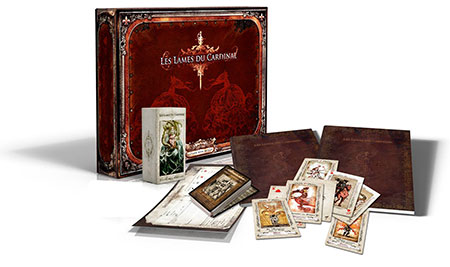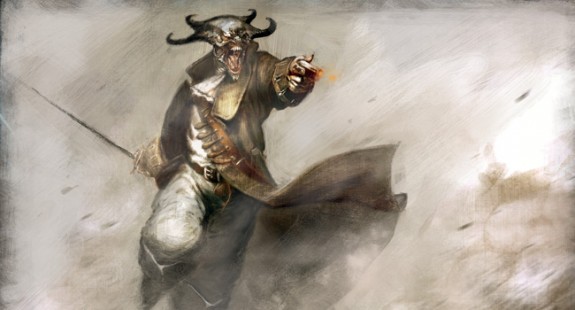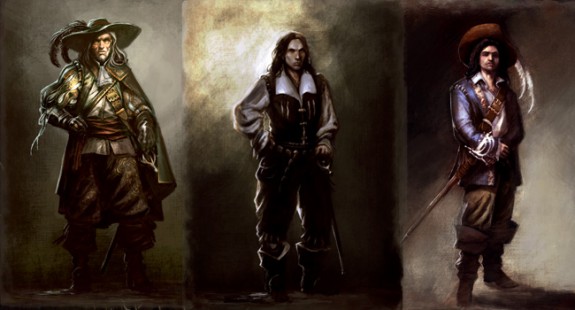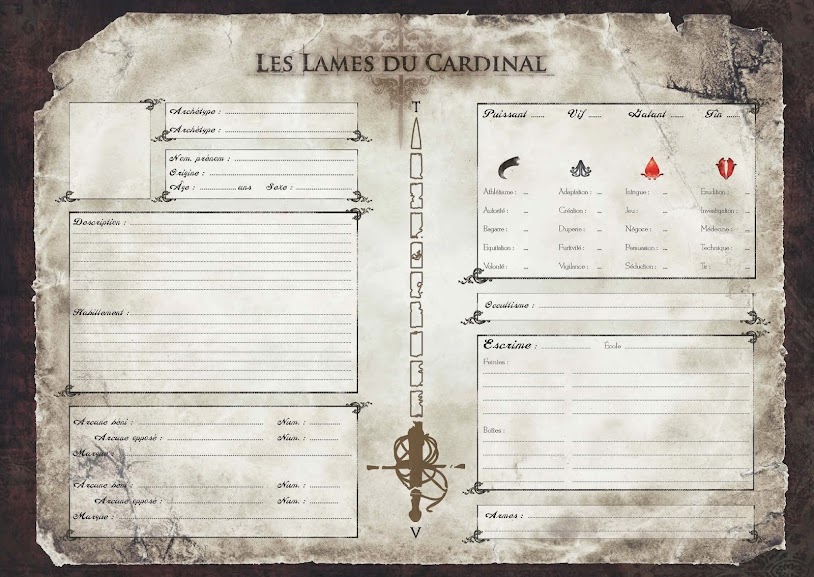To give the players some more info about the feints & special moves allowed by the various fencing schools, here is the translation of everything.
As a reminder: you may choose as many moves&feints as half your score of fencing (rounded up). Then, Simon & Chylli would choose 3 moves&feints in the German list, Thopthes 4 in the German list, & H 3 moves in the Italian School.
Taking into account your score (6 or 7), your ability to take a deep breath (discard & draw 3 cards), the use of Tenacity (draw two more cards)… the 2 & 3 heads’ moves are quite able to be made.
Feints may be played once during each assault, without condition.
Spanish
Feints
Dexterity
Draw two cards at anytime during an assault. You may keep the red “scales” cards, and must discard any other card.
Parade
discard a black “claw” card: it becomes a red “scale” card of the same value
Magical circle
Instead of playing or discarding one red “scales” card, you may keep it for the coming assault
Untouchable
If you do not have the lead at the beginning of a given assault, and if your first played card is a red “scales” card, you immediately benefit from a free parry.
Special moves
Botte de De Torre (2 heads)
You make a very precise parry. Your opponent looses all his defenses.
Botte de Narvaez (2 heads)
Your parry destabilise all your opponents: they all loose one attack
Botte de Cervantès (3 heads)
You immediately disarm your opponent.
Botte d’Almadès (3 heads)
You move faster than any of your opponent, and may inflict damages. Any red “scale” head played during this assault inflict one point of damage to any of your opponent (you choose).
Botte de Carranza (4 heads)
You immediately neutralise your opponent. He lays in front of you, unable to move or unconscious.
Italian
Feints
Volte
If you play two consecutive red “blood” cards, you may draw one card
Main-gauche
If you have a main-gauche (parrying dagger) and a rapier, you may play a red “blood” card as a black “breath” card of the same value: you attack with your main-gauche.
Dodge
Play any red “blood” card: you take the lead, notwithstanding the value of the card played
Braid
Instead of playing or discarding one red “blood” card, you may keep it for the coming assault
Special moves
Botte d’Agrippa (2 heads)
Your movements are followed by a powerful volte: you hit multiple opponents. Any red “blood” head played during the assault counts as a free attack on one or more of your opponents.
Botte de Fabris (2 heads)
You make an evasive volte. The combat is left behind: you are out of range for your opponent, and you keep the lead
Botte de Viggiani (3 heads)
Your opponents are discouraged and exhausted by your habilety. All your opponents loose one tenacity point.
Botte de Silvie (3 heads)
You make a circular move that end behind one of your opponent’s back. If you have black “claw” cards or black “breath” cards left, you may use all or part of them on your opponent: he cannot parry.
Botte de Marozzo (4 heads)
You make a beautiful volte, which cuts your opponent’s throat or decapitates him.
German
Feints
Brawl
You fight with your sword and your fists. You may change the value of one of your black “claw” card by one point.
Charge
At the beginning of a combat, if you have the lead, you may play a black “claw” card: notwithstanding its value, you keep the lead.
Tactic
Instead of playing or discarding one black “claw” card, you may keep it for the coming assault
Main-gauche
If you have a main-gauche (parrying dagger) and a rapier, you may play a black “claw” card. It is considered as being a red “scale” card of the same value. The played black “claw” card still counts as a black “claw” card if needed for making a special move (botte).
Special moves
Botte de Ringeck (2 heads)
You endlessly hit your opponent: he looses all his attacks.
Botte de Kal (2 heads)
You move past your opponent’s weapon, and give him a powerful kick. He is lying on the ground, some distance away, and lost a defense. If you have more than one opponent, your throw him in their direction, creating a brief chaos among them. They all loose one defense, for this assault, and you take (or keep) the lead.
Botte de Talhoffer (3 heads)
You give a very powerful hit to your opponent: you inflict 3 injuries, ignoring armour, and impossible to parry or to dodge.
Botte de Liechtenauer (3 heads)
You attack with the edge of your weapon, hitting everything in the path of your blade. All the black “claw” heads already played during the assault count as an attack. You may choose who you hit, and how many times.
Botte de Von Dantzig (4 heads)
You immediately knock-out or kill one of your opponents by hitting his head.
French
Feints
Lunge
Play any black “breath” card: you take the lead, notwithstanding the value of the card played
Swing
If you play two consecutive black “breath” cards, you may draw one card
Manage your strenght
Instead of playing or discarding one black “breath” card, you may keep it for the coming assault
Mislead
Play a red “blood” card. It is considered as being a black “breath” card of the same value
Special moves
Botte de Le Perche (2 heads)
You use your sword to make a circular move around your opponent’s weapon. If he does not immediately play a defense, he is disarmed. You keep the lead.
Botte de Desbordes (2 heads)
You are at ease in the combat: you find a renewed energy. You gain one tenacity point.
Botte de Besnard (3 heads)
You hit one of your opponent’s artery: he starts loosing his blood. He immediately looses one tenacity/vitality point, then one per coming assault.
Botte de Sainct-Didier (3 heads)
You are unbelievably fast. You immediately gain 3 “fictive” breath cards, which you can immediately use on one or more of your opponent(s), or one one opponent by throwing your sword at him. You loose your sword (it is stick into your opponent’s body)
Botte de La Touche (4 heads)
You immediately kill one of your opponents plunging to his head or chest.
ps. once again, I translated this quickly to give it to you… feel free to suggest any better translation.








 )
)



